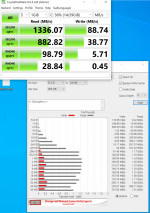remonv76
Dabbler
- Joined
- Dec 27, 2014
- Messages
- 49
Can somebody explain to me how the impact works of sync writes?
We all know that it has an significant performance impact on write speed. Like 5MB/s is quite normal with sync writes and without a SLOG.
Now when we add a SLOG, all writes go to the SLOG, which in turn writes the data every 5 sec to the pool. Default setting of the SLOG is around 4GB.
Now lets asume we have a 24xdisk SAS pool with an NVME SLOG and sync writes is enabled on the zpool. Does this mean SLOG will write the data to the SAS pool with 5MB/s or is sync writes enabled only on the SLOG (performance impact on SLOG) and full performance is gained on the SAS pool?
If the performance impact is still on the SAS pool, then the 4GB SLOG dump to the pool will take 10 minutes with 5MB/s. I can not imagine this is the case. Hope somebody can clear this up.
We all know that it has an significant performance impact on write speed. Like 5MB/s is quite normal with sync writes and without a SLOG.
Now when we add a SLOG, all writes go to the SLOG, which in turn writes the data every 5 sec to the pool. Default setting of the SLOG is around 4GB.
Now lets asume we have a 24xdisk SAS pool with an NVME SLOG and sync writes is enabled on the zpool. Does this mean SLOG will write the data to the SAS pool with 5MB/s or is sync writes enabled only on the SLOG (performance impact on SLOG) and full performance is gained on the SAS pool?
If the performance impact is still on the SAS pool, then the 4GB SLOG dump to the pool will take 10 minutes with 5MB/s. I can not imagine this is the case. Hope somebody can clear this up.

